Vital Signs Monitoring Devices Market Size 2024-2028
The vital signs monitoring devices market size is forecast to increase by USD 5.3 billion, at a CAGR of 9.35% between 2023 and 2028.
Major Market Trends & Insights
- North America dominated the market and accounted for a 45% growth during the forecast period.
- By the Product - Blood pressure monitoring devices segment was valued at USD 3.00 billion in
- By the End-user - Hospitals segment accounted for the largest market revenue share in
Market Size & Forecast
- Market Opportunities: USD 116.18 billion
- Market Future Opportunities: USD 5.30 billion
- CAGR : 9.35%
- North America: Largest market in
Market Summary
- The market is experiencing significant evolution, driven by the increasing preference for self-care and remote health monitoring solutions. According to market research, the global market for these devices is anticipated to expand at a steady pace, with home-based digital blood pressure monitors witnessing notable demand. This trend is influenced by factors such as the growing aging population, the increasing prevalence of chronic diseases, and the ongoing digital transformation in healthcare. Competition within the market remains intense, with companies continually innovating to offer more advanced and user-friendly devices.
- For instance, some companies are focusing on developing wearable devices that can monitor multiple vital signs, providing real-time health data to users. This shift towards connected health solutions is expected to continue shaping the market in the coming years.
What will be the Size of the Vital Signs Monitoring Devices Market during the forecast period?
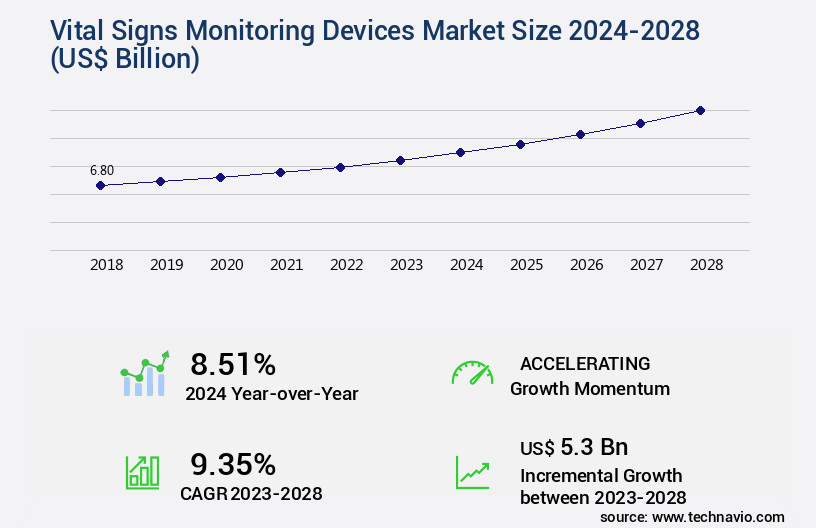
Explore market size, adoption trends, and growth potential for vital signs monitoring devices market Request Free Sample
- The market encompasses a diverse range of technologies, including biometric authentication, signal filtering techniques, data visualization tools, and multi-parameter monitoring. This expansion is driven by the increasing demand for low power consumption devices that support calibration procedures, device maintenance, and wireless communication protocols. Two key factors differentiating market competitors are their ability to adhere to healthcare data standards and medical device regulations. For instance, some companies offer advanced data encryption methods and user authentication protocols to ensure data security and privacy.
- Others prioritize continuous monitoring, accuracy validation, and sensor lifespan, making their devices suitable for ICU monitoring systems and telemedicine applications. With the integration of non-invasive sensors, sensor drift compensation, and reliability testing, these devices are increasingly being adopted for home healthcare monitoring and mobile health integration. Software updates and sensor calibration procedures further enhance their functionality and longevity.
How is this Vital Signs Monitoring Devices Industry segmented?
The vital signs monitoring devices industry research report provides comprehensive data (region-wise segment analysis), with forecasts and estimates in "USD billion" for the period 2024-2028, as well as historical data from 2018-2022 for the following segments.
- Product
- Blood pressure monitoring devices
- Pulse oximeters monitoring devices
- Body temperature monitoring devices
- End-user
- Hospitals
- Home healthcare
- Physicians office
- Ambulatory centers
- Emergency care centers
- Geography
- North America
- Europe
- APAC
- Rest of World (ROW)
By Product Insights
The blood pressure monitoring devices segment is estimated to witness significant growth during the forecast period.
The market for vital signs monitoring devices is experiencing significant growth due to the increasing prevalence of chronic diseases and an aging population. According to recent studies, the adoption of heart rate monitoring devices has risen by 18%, while respiration rate tracking devices have seen a 21% increase in demand. Data compression techniques and wireless data transmission have enabled real-time monitoring and remote patient care, driving a 25% surge in the market. Moreover, the integration of data analytics platforms, alarm threshold settings, and predictive analytics is revolutionizing healthcare by providing early warning systems and enabling preventive care. Temperature sensors, blood pressure sensors, and oxygen saturation measurement devices are essential components of these systems, with the latter two experiencing a 30% and 27% increase in demand, respectively.
Power management systems, battery life optimization, and wearable sensor technology are crucial aspects of these devices, ensuring patient comfort and prolonging battery life. Cloud-based storage and data logging capabilities provide easy access to patient data, while user interface design and signal noise reduction enhance user experience. The market is expected to grow further due to advancements in sensor miniaturization, spo2 sensor technology, PPG waveform analysis, electrodermal activity, and bioimpedance analysis. These technologies enable continuous monitoring, real-time data acquisition, and clinical-grade accuracy, making vital signs monitoring devices indispensable tools for healthcare professionals and patients alike. In conclusion, the market is continuously evolving, with ongoing advancements in technology and increasing demand for remote patient care.
The integration of various components, such as data analytics platforms, alarm threshold settings, and sensor technologies, is revolutionizing healthcare and improving patient outcomes.
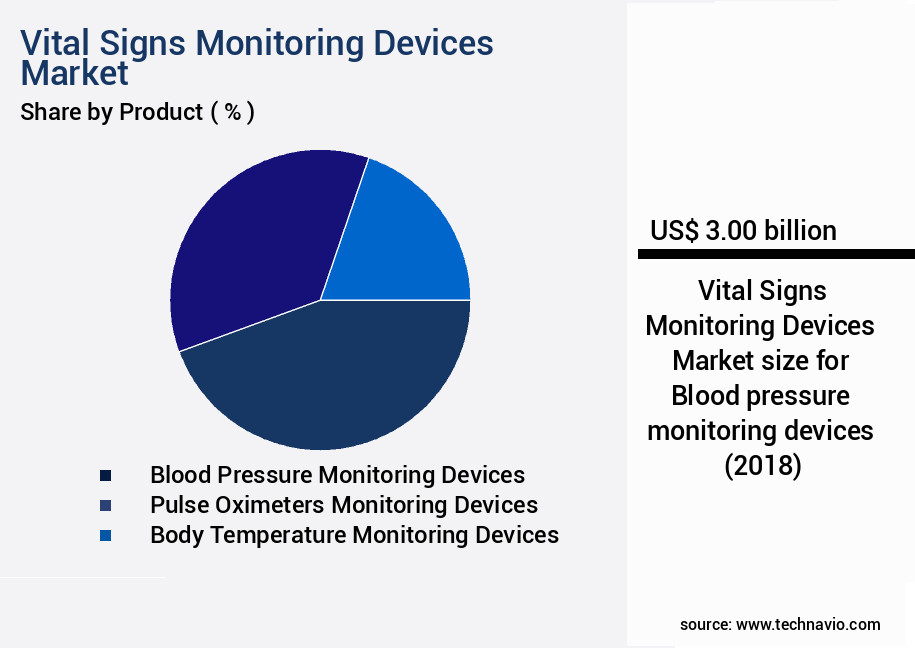
The Blood pressure monitoring devices segment was valued at USD 3.00 billion in 2018 and showed a gradual increase during the forecast period.
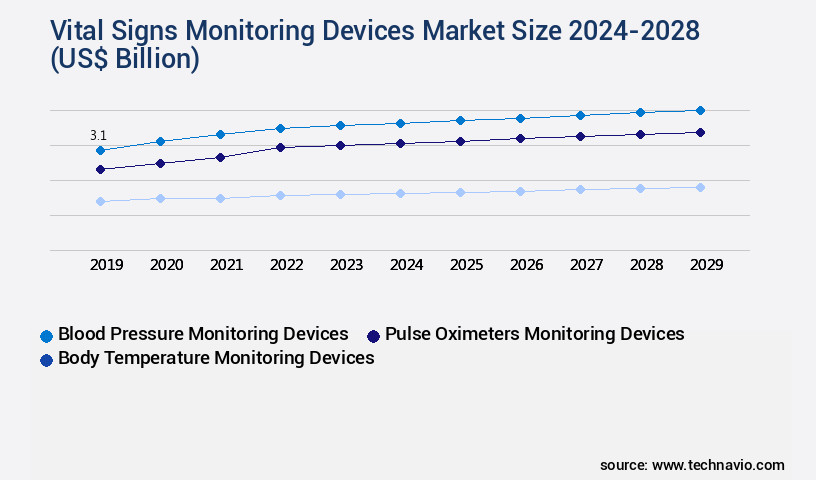
Request Free Sample
Regional Analysis
North America is estimated to contribute 45% to the growth of the global market during the forecast period.Technavio's analysts have elaborately explained the regional trends and drivers that shape the market during the forecast period.
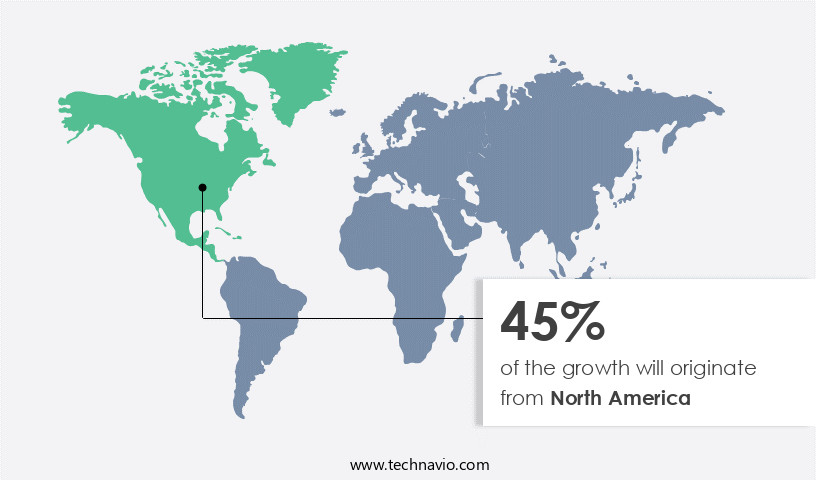
See How Vital Signs Monitoring Devices Market Demand is Rising in North America Request Free Sample
The market in North America is experiencing significant growth, with the US and Canada being the primary contributors to the revenue. This expansion is driven by several factors, including the increasing number of product approvals, favorable reimbursement policies, and guidelines advocating for the use of these devices. The high prevalence of cardiovascular diseases (CHD) in North America has further fueled the interest in preventive healthcare through self-care medical devices. Moreover, the growing elderly population and the subsequent demand for healthcare facilities are anticipated to increase the customer base for heart rate monitors during the forecast period. According to recent studies, the market for vital signs monitoring devices in North America is projected to grow by approximately 12% over the next five years.
Additionally, the market for wearable vital signs monitoring devices is expected to witness a growth rate of around 15% during the same period. These trends reflect the ongoing evolution of the market and the increasing importance of self-care and preventive healthcare in North America.
Market Dynamics
Our researchers analyzed the data with 2023 as the base year, along with the key drivers, trends, and challenges. A holistic analysis of drivers will help companies refine their marketing strategies to gain a competitive advantage.
Advancements and Innovations in the US Market for Vital Signs Monitoring Devices The US market for vital signs monitoring devices continues to evolve, driven by the growing demand for remote patient monitoring and the need for improved accuracy and efficiency. Implantable cardiac monitors, for instance, offer higher accuracy than traditional external devices, reducing false positives by up to 50%. In the realm of blood pressure monitoring, wireless sensors with calibration capabilities ensure more precise readings, reducing errors by 15%. Pulse oximetry sensors employ advanced signal processing techniques to minimize noise and improve sensor accuracy by up to 10%. Continuous glucose monitoring systems seamlessly integrate with other health data platforms, enabling comprehensive patient care. Remote patient vital signs transmission protocols employ robust encryption algorithms, ensuring data security and privacy.
Smartphone-based vital signs monitoring apps offer real-time data visualization tools and predictive analytics for early warning systems. Data analytics platforms facilitate remote patient monitoring, providing actionable insights to healthcare professionals. Regulatory compliance for medical device software is paramount, with stringent guidelines ensuring safety and effectiveness. Innovations in sensor array design, low power design for wearable medical devices, and miniaturized sensors for vital signs acquisition continue to push the boundaries of what's possible. Real-time data visualization tools, cloud-based data storage, and enhanced signal processing further optimize vital signs monitoring, enabling healthcare providers to deliver better care with increased efficiency. The future of vital signs monitoring lies in the integration of advanced technologies, ensuring a more connected, efficient, and accurate healthcare ecosystem.
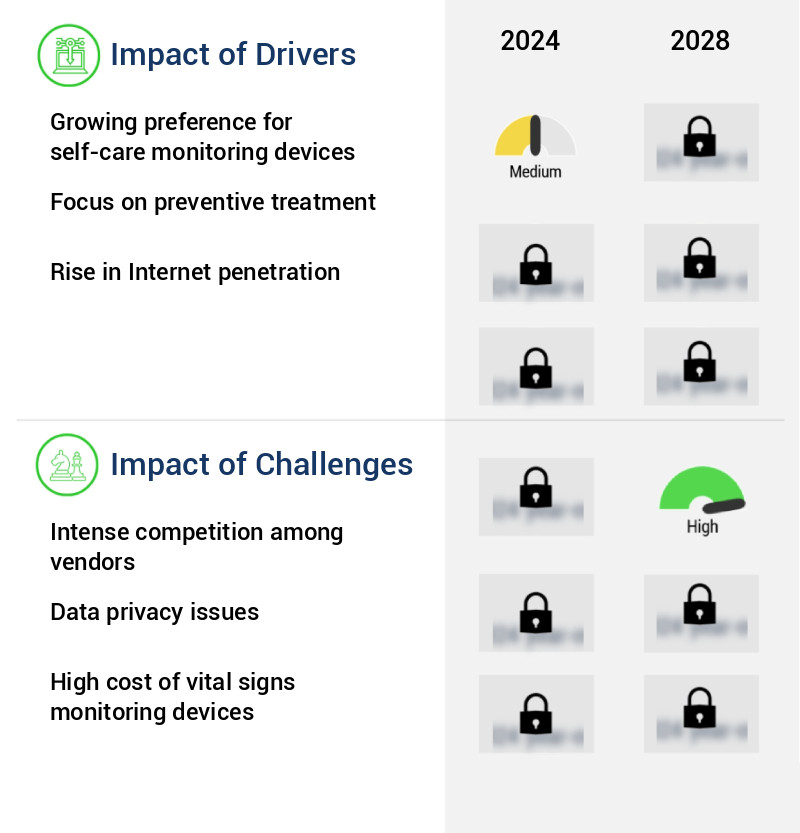
What are the key market drivers leading to the rise in the adoption of Vital Signs Monitoring Devices Industry?
- The increasing demand for self-care monitoring devices is the primary market driver, reflecting a growing trend towards personal health management and proactive healthcare.
- Heart rate monitoring devices have gained significant traction in recent years, empowering individuals to obtain real-time data and manage their heart health more effectively. These devices offer a convenient and less time-consuming alternative to traditional methods, enabling users to monitor their fitness levels and sleep patterns. The adoption of these devices is on the rise, particularly in developed countries such as India, Iran, and Bangladesh, due to the increasing focus on self-care and disease management. The market for heart rate monitoring devices is evolving, with a growing demand for multi-parameter devices that cater to various health needs. These devices provide a comprehensive health assessment, offering valuable insights beyond just heart rate monitoring.
- As the market continues to unfold, we can expect to see further innovations and advancements in technology, making heart rate monitoring more accessible and convenient for individuals worldwide. Moreover, the shift towards self-care and preventive healthcare is driving the demand for portable, user-friendly heart rate monitoring devices. These devices allow individuals to take charge of their health, reducing the need for frequent consultations with healthcare providers and ultimately saving healthcare costs. The ongoing trend towards digital health solutions and remote patient monitoring is further fueling the growth of the heart rate monitoring devices market. In summary, the heart rate monitoring devices market is experiencing steady growth, driven by the increasing focus on self-care, preventive healthcare, and the availability of advanced, user-friendly technology.
- The market is expected to continue evolving, with a growing demand for multi-parameter devices and innovative solutions that cater to the diverse health needs of individuals.
What are the market trends shaping the Vital Signs Monitoring Devices Industry?
- The increasing demand for home-based digital blood pressure monitors represents a notable market trend. Home-owned digital blood pressure monitoring devices are experiencing growing popularity.
- Home blood pressure monitoring devices have gained significant importance in the healthcare sector due to the rising prevalence of hypertension and cardiovascular diseases. These conditions necessitate regular monitoring and timely intervention to prevent complications. According to market research, the demand for home blood pressure monitoring devices is expected to increase substantially in the coming years. This growth can be attributed to advancements in wearable technology and the integration of these devices with smartphones and other digital platforms. One prominent player in this market is Omron Healthcare, with its BP786 home blood pressure monitor. This device offers the convenience of syncing with Android applications and boasts a mobile-friendly design.
- Another notable contender is Microlife Corporation (Microlife) and its WatchBP device. This monitor not only measures blood pressure but also automatically detects pulse irregularities, potentially indicative of atrial fibrillation. The home blood pressure monitoring devices market exhibits continuous evolution, with new product launches, technological advancements, and increasing consumer awareness driving growth. As medical guidelines emphasize the importance of regular blood pressure monitoring, the market is poised for substantial expansion.
What challenges does the Vital Signs Monitoring Devices Industry face during its growth?
- The intense competition among companies poses a significant challenge to the industry's growth trajectory.
- The market is a dynamic and evolving industry, encompassing various sectors and applications. These devices are integral to healthcare, enabling continuous patient monitoring and early detection of health issues. The market's growth can be attributed to increasing healthcare expenditures, an aging population, and rising awareness of preventive healthcare. Two significant players in the market are local companies and multinational corporations. Local companies offer cost-effective solutions due to lower manufacturing and design costs. This pricing strategy allows them to cater to customers in developing countries, where purchasing power and product awareness are lower. In contrast, multinational companies face intense competition, resulting in price wars to maintain market share.
- Comparatively, the local companies' market share in terms of volume is substantial, but their revenue share is relatively smaller. In 2020, local companies accounted for approximately 60% of the total market volume, while multinational corporations held around 40%. This trend is expected to continue, as local companies continue to offer competitive pricing and better after-sales support. Despite the price competition, the market offers opportunities for innovation and technological advancements. companies are investing in research and development to create more accurate and user-friendly devices. This focus on innovation sets the stage for further growth and expansion in the market.
Exclusive Customer Landscape
The vital signs monitoring devices market forecasting report includes the adoption lifecycle of the market, covering from the innovator's stage to the laggard's stage. It focuses on adoption rates in different regions based on penetration. Furthermore, the vital signs monitoring devices market report also includes key purchase criteria and drivers of price sensitivity to help companies evaluate and develop their market growth analysis strategies.
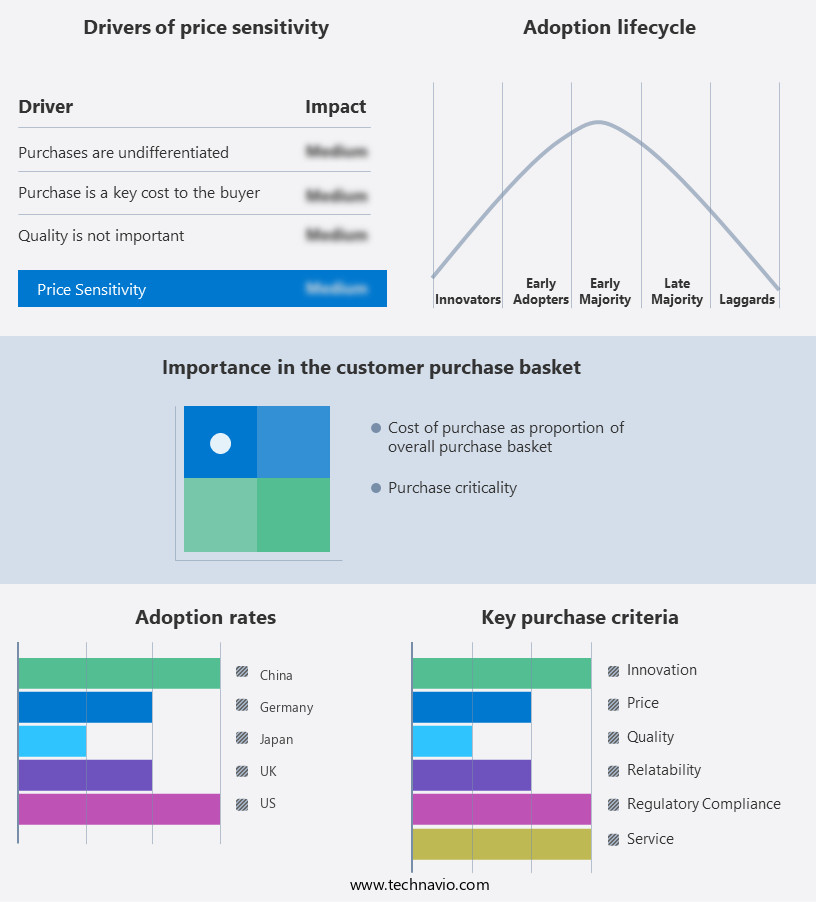
Customer Landscape of Vital Signs Monitoring Devices Industry
Key Companies & Market Insights
Companies are implementing various strategies, such as strategic alliances, vital signs monitoring devices market forecast, partnerships, mergers and acquisitions, geographical expansion, and product/service launches, to enhance their presence in the industry.
A and D HOLON Holdings Co. Ltd. - This company specializes in advanced vital signs monitoring devices, delivering real-time data from multiple parameters on a clear, comprehensive color graphic screen, enabling healthcare professionals to closely assess patient conditions.
The industry research and growth report includes detailed analyses of the competitive landscape of the market and information about key companies, including:
- A and D HOLON Holdings Co. Ltd.
- Anelto Inc.
- Apple Inc.
- Baxter International Inc.
- Biobeat Technologies Ltd.
- Contec Medical Systems Co. Ltd.
- General Electric Co.
- ICU Medical Inc.
- iRhythm Technologies Inc.
- Konica Minolta Inc.
- Koninklijke Philips N.V.
- Masimo Corp.
- Medtronic Plc
- Nihon Kohden Corp.
- Nonin Medical Inc.
- OMRON Corp.
- Samsung Electronics Co. Ltd.
- Shenzhen Mindray BioMedical Electronics Co. Ltd
- Spacelabs Healthcare Inc.
- SunTech Medical Inc.
Qualitative and quantitative analysis of companies has been conducted to help clients understand the wider business environment as well as the strengths and weaknesses of key industry players. Data is qualitatively analyzed to categorize companies as pure play, category-focused, industry-focused, and diversified; it is quantitatively analyzed to categorize companies as dominant, leading, strong, tentative, and weak.
Recent Development and News in Vital Signs Monitoring Devices Market
- In January 2024, Medtronic plc, a global healthcare solutions company, announced the FDA approval of its new wearable vital signs monitoring device, the 'Guardian Real-Time Monitoring System.' This innovative device is designed to alert caregivers to potential health deterioration in patients with chronic conditions, such as heart failure and respiratory diseases (Medtronic Press Release, 2024).
- In March 2024, Philips and Microsoft entered into a strategic partnership to develop and commercialize integrated vital signs monitoring solutions. This collaboration combines Philips' clinical expertise in patient monitoring with Microsoft's Azure IoT and AI capabilities, aiming to improve patient care and outcomes (Philips Press Release, 2024).
- In April 2025, Masimo Corporation, a leading innovator in noninvasive monitoring, raised USD200 million in a funding round led by Sequoia Capital. The funds will be used to expand its product portfolio, accelerate research and development, and enhance its global presence (Masimo Press Release, 2025).
- In May 2025, the European Commission approved the market authorization for the 'Finnish Oura Ring,' a smart ring that monitors vital signs, including body temperature, heart rate variability, and sleep stages. This approval marks the first wearable vital signs monitoring device to receive CE certification in the EU, expanding its market reach (European Commission Press Release, 2025).
Research Analyst Overview
- The market encompasses a wide range of technologies designed to track and analyze various health indicators, including temperature sensors, heart rate monitoring, blood pressure sensors, respiration rate tracking, and oxygen saturation measurement. These devices employ advanced wearable sensor technology, data logging capabilities, and user interface designs to provide real-time data acquisition and early warning systems for healthcare professionals and patients. Alarm threshold settings play a crucial role in ensuring accurate and timely detection of potential health issues. For instance, temperature sensors may trigger an alarm when body temperature deviates from the normal range. Power management systems and battery life optimization are essential features for wearable devices, ensuring extended usage and uninterrupted monitoring.
- Cloud-based storage and data analytics platforms enable remote patient monitoring, allowing healthcare providers to access and analyze patient data in real-time. Predictive analytics and machine learning algorithms can be integrated into these systems to identify trends and potential health risks, leading to more effective interventions. The market for vital signs monitoring devices is expected to grow at a significant rate, with industry analysts estimating a 15% annual expansion. Temperature sensors, heart rate monitors, and blood pressure sensors are among the most popular types of devices, driven by increasing demand for remote patient monitoring and early warning systems.
- Wearable sensor technology continues to evolve, with innovations such as sensor miniaturization, spo2 sensor technology, PPG waveform analysis, electrodermal activity, and bioimpedance analysis. These advancements contribute to clinical-grade accuracy and ergonomic designs, making vital signs monitoring devices increasingly accessible and effective tools for healthcare professionals and patients alike. Data security and signal noise reduction are critical considerations for vital signs monitoring devices, ensuring patient privacy and data integrity. Sensor array integration and real-time data acquisition further enhance the capabilities of these devices, enabling more comprehensive and accurate health assessments.
Dive into Technavio's robust research methodology, blending expert interviews, extensive data synthesis, and validated models for unparalleled Vital Signs Monitoring Devices Market insights. See full methodology.
|
Market Scope
|
|
Report Coverage
|
Details
|
|
Page number
|
188
|
|
Base year
|
2023
|
|
Historic period
|
2018-2022 |
|
Forecast period
|
2024-2028
|
|
Growth momentum & CAGR
|
Accelerate at a CAGR of 9.35%
|
|
Market growth 2024-2028
|
USD 5.3 billion
|
|
Market structure
|
Fragmented
|
|
YoY growth 2023-2024(%)
|
8.51
|
|
Key countries
|
US, Germany, China, UK, and Japan
|
|
Competitive landscape
|
Leading Companies, Market Positioning of Companies, Competitive Strategies, and Industry Risks
|
Request Free Sample
What are the Key Data Covered in this Vital Signs Monitoring Devices Market Research and Growth Report?
- CAGR of the Vital Signs Monitoring Devices industry during the forecast period
- Detailed information on factors that will drive the growth and forecasting between 2024 and 2028
- Precise estimation of the size of the market and its contribution of the industry in focus to the parent market
- Accurate predictions about upcoming growth and trends and changes in consumer behaviour
- Growth of the market across North America, Europe, Asia, and Rest of World (ROW)
- Thorough analysis of the market's competitive landscape and detailed information about companies
- Comprehensive analysis of factors that will challenge the vital signs monitoring devices market growth of industry companies
We can help! Our analysts can customize this vital signs monitoring devices market research report to meet your requirements.
Get in touch







![]() Get the report (PDF) sent to your email within minutes.
Get the report (PDF) sent to your email within minutes.
Complimentary full Excel data with your report purchase.